Peru
Food
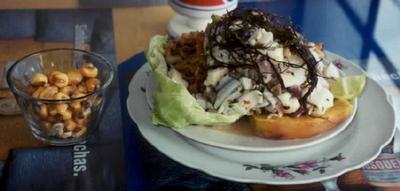
| Ceviche is Peru's national dish. It is raw fish (often white sea
bass but sometimes other fish or mixed seafood) marinated in Peru's highly
acidic limes (which "cooks" the fish) and mixed with onions
and a little hot pepper. It is generally served with a slice of sweet potato
and cancha, or toasted corn kernels. It is also usually accompanied
by a cold cup of leche de tigre, the liquid that drains out of the ceviche,
and a hot limey fish broth soup, which appears to be made with the fish parts not
used in the main dish.
|
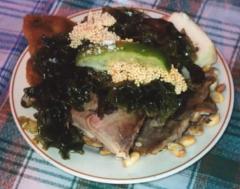 More popular in the highlands is cuy, or guinea pig.
Before they are roasted, they look exactly like guinea pigs you'd
see in a pet store. Incidentally, I stopped by a pet store in a
modern shopping mall in Lima, and found the usual assortment of pets
you'd find in the States except for guinea pigs, which I only saw in
rural food markets. These things take
forever to eat - there's not much meat on them. I think that in the
countryside they are allowed to run around the kitchen and eat scraps
until the fateful day comes when the slowest or dumbest one is
cornered then baked or roasted.
The dish on the right is chiri uchu, which is served in the
Cusco region for the Corpus Christi festival. It is a plate stacked
high with a piece of corn bread, roasted guinea pig,
chicken, pork, sausage, water weeds, fish roe, a slice of cheese, pepper
slices, and cancha.
It is eaten with the hands, which makes it a messy affair.
More popular in the highlands is cuy, or guinea pig.
Before they are roasted, they look exactly like guinea pigs you'd
see in a pet store. Incidentally, I stopped by a pet store in a
modern shopping mall in Lima, and found the usual assortment of pets
you'd find in the States except for guinea pigs, which I only saw in
rural food markets. These things take
forever to eat - there's not much meat on them. I think that in the
countryside they are allowed to run around the kitchen and eat scraps
until the fateful day comes when the slowest or dumbest one is
cornered then baked or roasted.
The dish on the right is chiri uchu, which is served in the
Cusco region for the Corpus Christi festival. It is a plate stacked
high with a piece of corn bread, roasted guinea pig,
chicken, pork, sausage, water weeds, fish roe, a slice of cheese, pepper
slices, and cancha.
It is eaten with the hands, which makes it a messy affair.
Amazonas
|
Iquitos is a large city on the Amazon inaccessible by road.
The center is dominated by buildings from the 19th century rubber
boom, during which Portuguese and Italian tiles were brought in
to adorn the facades. The city has since sprawled out, even into
the Amazon River itself with houses on stilts.
The tourists really don't come for the city - they all go to the
ecotourism facilities on the nearby rivers and lakes.
| 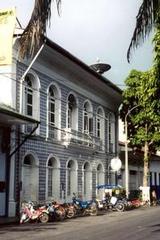
|

| I went with a friend to Muyuna Lodge,
about 100km upriver (south)
of Iquitos on the Yanayacu tributary.
Surprisingly, we were the only tourists visiting the lodge at
the time, and we did not see any other tourists in the Amazon, even though
there were other lodges just upriver.
We spent the bulk of our time on the water, the main form of transport in
the area. From the water, you can see river dolphins in the day and
the occasional caiman at night.
|
Qoyllur R'iti
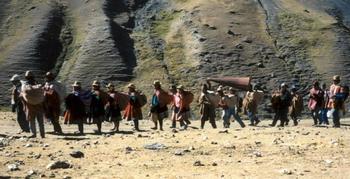
From Trinity Sunday (May or June) to the following Tuesday, there
is a festival dedicated to Seņor de Qoyllur R'iti,
or the Snow Star, in the mountains by the tiny Andean village of Mawayani
near Mount Ausangate.
It is nominally a Christian festival, but after seeing people
bring down chunks of sacred ice from the nearby glacier,
the pre-Christian roots became apparent. To get there, I took
an uncomfortable overnight bus from Cusco to Mawayani. As one hits the
high mountain passes near Mawayani, the road turns to packed dirt and the
landscape is lunar in its barrenness. From Mawayani, it is a
two-to-three-hour hike up mountain trails to the church of Qoyllur R'iti.
At 15,000 feet, I found this to be a tiring and nauseating climb.
At least, I thought, I was not one of the poor harp players, who carried
their instruments on their backs all the way up. I watched groups of
dancers, musicians, and other pilgrims snake their way up the trails as
I sat panting for breath.
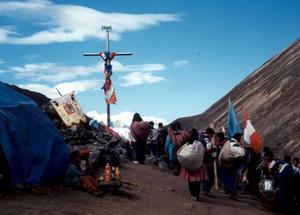
| There were crosses erected on mounds of rocks along the trail. When
a group encountered one of these, the musicians played a simple huayno
tune while the rest of the group waited in line to prostrate themselves
in front of the cross.
|
| The church was the only structure at the top of the trail.
The rest of the area was thick with tents and campfire smoke.
The sacred glacier was perhaps a kilometer further up and it was covered
with pilgrims retrieving blocks of ice to take back with them.
I was concerned when a reporter e-mailed me
the next year asking me if I did, in fact, see a glacier. Global warming!
| 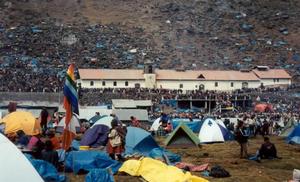
|
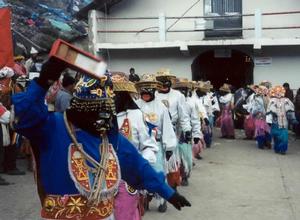
| The entire area was full of people singing and dancing all night.
Some dances seemed to represent events in Spanish history, such as the
Christians and Moors.
|
| Others commemorated events in Peru's history, like the encounters
between the Amazonian people and the Spaniards. Many of the dances
had strong narratives. I watched a dancer dressed as a Spanish governor
alternately whipping prostrated indigenous people, then helping them up
so he could embrace them. I suppose that's one way of portraying a colonial
relationship.
| 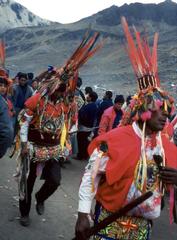
|
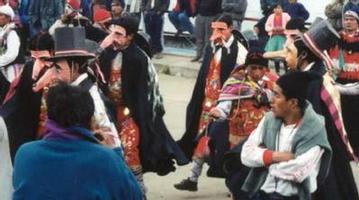
| The masks representing the faces of foreign authority figures were
usually not flattering.
|
| Many dances had stylized Christian gestures. Lots of kneeling and
praying.
| 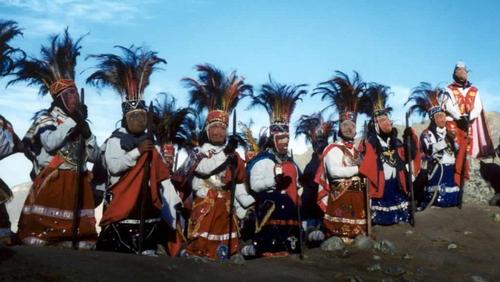
|
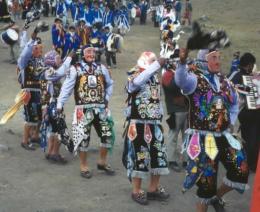
| But usually, the dancers just marched and whirled to the music,
occasionally whacking onlookers with whips.
|
| And some dancers had dead vicuņas on their backs.
| 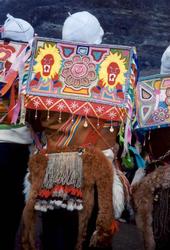
|
Macchu Picchu
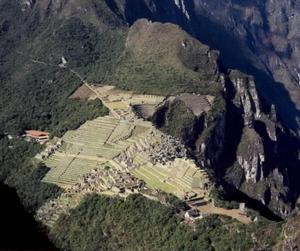
| Macchu Picchu is Peru's tourist ground zero.
I briefly considered becoming the first tourist in Peruvian history
not go to Macchu.
It is only accessible by train, and tourists are not allowed to take
the reasonably-priced local train.
I took a one-and-a-half-hour train ride from Ollantaytambo
to Aguas Calientes, the town at the base of Macchu Picchu, for $27.50.
At first I was outraged by the price, but as I climbed aboard and
realized I was the only passenger, I thought it was awfully decent of
them to run a fully-staffed diesel train for my benefit for the price of
my ticket.
The trains from Cusco to Aguas Calientes had one-way prices ranging from
$10 to over $30. The difference in prices appeared to be arbitrary,
as the trains for the different classes were identical. By imposing
different fares, I am guessing that the "classes" were self-selecting.
|
| I think that the beautiful mortarless stonework is reserved for
the few religious structures, while the
rest of the buildings and walls were rough. I like this odd
niche - the masons had carefully fitted their stones to the
curving walls of this little cave.
| 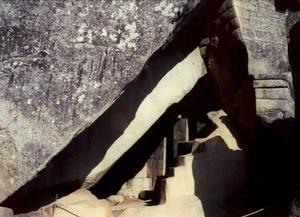
|
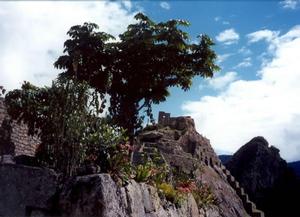
| 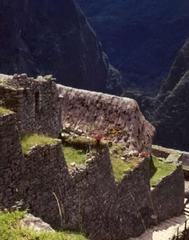
| The other nice thing about Macchu Picchu's location is that it is
often shrouded in clouds, allowing beautiful bromeliads to
grow among the ruins.
|
Viracocha
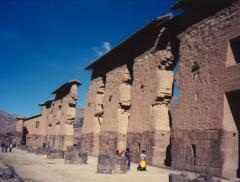
| Viracocha is the Incan god of creation, and his temple near
Raqchi was one of the largest structures created by the Incas.
All that remains of the largest building is one of the central
walls, which has a stone base with an adobe wall on top.
The little roof on top was added by archaeologists
to protect the adobe. The area around the ruins is littered
with jagged black volcanic rock, the remnants of an old punishment
administered by the creator god.
|

| There was only one dance stage at the Viracocha festival, and it was
difficult to get near. The dances I saw did not tell stories like many of
those at Qoyllur R'iti, but the costumes were just as interesting.
This group danced around with human skulls.
|

| Watching this group of dancers among the ruins was more enjoyable
than straining to see the main stage.
They were being filmed but tolerated
the few of us who happened to be there watching.
A group of about ten musicians were off to the side singing and playing.
|
Lima
I have almost no pictures from Lima. The city is completely covered
in a low coastal fog (garua) for much of the winter, and the air
pollution makes the atmosphere more oppressive. I developed a cough after
a day in Lima, and it persisted for a week after I got back to the States.
On the bright side, there are fine restaurants, shops, and clubs in the city.
The old European architecture of some quarters would have been beautiful
had there been sunshine.
For me, Lima was an opportunity to eat fresh seafood.
I ate in a difficult-to-find place called "Costanera 700", named for
its address. It was featured in an article Calvin Trillin wrote for
the August 2000 Gourmet magazine, which I had read on the plane
back from China last year. An article in a November 2001 New York Times
described it as an exclusive restaurant where secret deals are
constantly made. The head chef of Costanera is Humberto Sato,
who is of Japanese descent. Lima has a large Asian population, as evidenced
by the enormous number of chifas, or Chinese restaurants, all over
the city. The restaurant was surprisingly hard to find despite the fact
that it is named for its address and is on a major road. I walked in
the unmarked entrance in a deserted industrial neighborhood to find an
empty cavernous room full of framed letters from old customers, including
Alberto Fujimori, Alan Garcia, Alejandro Toledo, and presidents and
ambassadors from all over South America.
Since I was dining alone (I mean really alone - there weren't any
other customers in the building), it was difficult for me to choose just one
dish, so I let the waiter choose a couple of half portions of entrees
featuring lenguado, or sole, which seemed to be the freshest
available fish. I started with the Ceviche Costanera, which was
an octopus ceviche presented on scallop shells. This was followed by
a Japanese interpretation of a sole ceviche. There were large
sushi-sized chunks of fish in a limey soy sauce mixture, garnished
with thin slices of white onion. It was a little less acidic than a
normal ceviche, and the onions were not immersed in the liquid.
The next course was a lightly poached filet of sole in what the waiter
told me was "mushi oil". If I were able to communicate in Spanish,
I'm sure things would have made more sense. Anyways, it
seemed to be a very light-tasting soy sauce. A very mild dish of
minced ginger in oil was on the side. The entire meal was excellent -
the fish was incredibly fresh.
After my meal, a member of Sato's family (possibly his
son) showed me around the restaurant. There was a little sushi bar on
the second floor as well as formal meeting rooms. He pointed out a
picture of Sato with former president Fujimori. As we were walking back
to my table, Humberto Sato himself showed up. He was unfortunately not
around when my meal was being prepared. Humberto is an older Japanese
guy who knows all about fish. He told me that 300 varieties of fish
lived in Peru's cold coastal currents. I asked him which market he
got his fish from, and he replied that you have to walk along the beach
at 4am and deal with the fishermen directly. That way, the fish would still
be alive by the time he got back to the restaurant. Humberto told me
that he was busy preparing to open another branch of his restaurant in
the expensive Miraflores district. The name of his new place?
Costanera 700.
I think this will be confusing, but clients will
take the time to track down this master chef.
Incidentally, Humberto said that he trained with (or trained?
I can't really understand Spanish.)
chef Matsuhisa
of Nobu, the incredibly popular place in Manhattan that Al Pacino co-owns.
Actually, my Spanish is really bad and it is possible that Humberto
said that he trained Matsuhisa.
I looked up Nobu in the NYC Zagat guide, and sure enough it said
that the cuisine is "Japanese Peruvian".
Think Japanese food with limes and chiles.
I used the links below to help prepare for my trip.
Lima
Excite
food in lima
Costanera 700 (1-566-0670) - Ceviche in San Miguel, 12:30pm to 4pm.
Closed Sundays and holidays. credit cards are accepted.
Cusco
Excite travel
qosqo
Cuszcoguide
roy davies (Inca Trail)
festivals near cusco
June 14 - Corpus Christi
June 10-19? - Festival de Qoyllur Rit'i - valley of Sinakara, on the town of
Mawayani, in Quispicanchis?,
Savvy traveler report,Peter Frost report (Trinity Sunday is June 10, so Qoyllur Riti should be from June 10-12)
Sunday before the 24th, Folk Festival in the Wiraqocha Inkan temple of the Raqchi village, district of San Pedro, Canchis province
Las Machitas: Avenida de la Infancia (get a taxi for 2 soles)
If you like fish and seafood and you don't mind being the only gringo in a crowded
restaurant, head down to Las Machitas at lunchtime - everyone else does. The
cebiche is excellent, as is the corvina a lo macho. A place to escape the tourist
hoards and have an 'authentic' Cusco eating experience.
Hostal Familiar, Calle Saphi 661 (239353). One of Cusco's best
budget options. Quiet and very safe; rooms are spartan, but cool,
clean and nicely furnished, though few have a private toilet. The
communal toilets and showers are very clean and there's usually
hot water in the mornings. Good breakfasts are served in the café
and there's free safety deposit, a cheap left- luggage system and
laundry service available. $5-10.
Manu
1997 travelogue to the Cultural Zone
Another trip
Living Edens PBS special
Machiguenga tribe
A˙azco
Iquitos
River dolphins
travelogue at Muyuna Lodge and
photos
go back!


 More popular in the highlands is cuy, or guinea pig.
Before they are roasted, they look exactly like guinea pigs you'd
see in a pet store. Incidentally, I stopped by a pet store in a
modern shopping mall in Lima, and found the usual assortment of pets
you'd find in the States except for guinea pigs, which I only saw in
rural food markets. These things take
forever to eat - there's not much meat on them. I think that in the
countryside they are allowed to run around the kitchen and eat scraps
until the fateful day comes when the slowest or dumbest one is
cornered then baked or roasted.
The dish on the right is chiri uchu, which is served in the
Cusco region for the Corpus Christi festival. It is a plate stacked
high with a piece of corn bread, roasted guinea pig,
chicken, pork, sausage, water weeds, fish roe, a slice of cheese, pepper
slices, and cancha.
It is eaten with the hands, which makes it a messy affair.
More popular in the highlands is cuy, or guinea pig.
Before they are roasted, they look exactly like guinea pigs you'd
see in a pet store. Incidentally, I stopped by a pet store in a
modern shopping mall in Lima, and found the usual assortment of pets
you'd find in the States except for guinea pigs, which I only saw in
rural food markets. These things take
forever to eat - there's not much meat on them. I think that in the
countryside they are allowed to run around the kitchen and eat scraps
until the fateful day comes when the slowest or dumbest one is
cornered then baked or roasted.
The dish on the right is chiri uchu, which is served in the
Cusco region for the Corpus Christi festival. It is a plate stacked
high with a piece of corn bread, roasted guinea pig,
chicken, pork, sausage, water weeds, fish roe, a slice of cheese, pepper
slices, and cancha.
It is eaten with the hands, which makes it a messy affair.
















